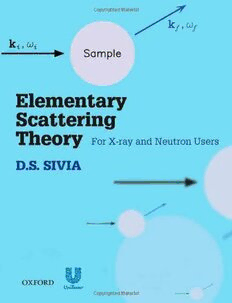
Elementary Scattering Theory: For X-ray and Neutron Users PDF
Preview Elementary Scattering Theory: For X-ray and Neutron Users
ELEMENTARYSCATTERINGTHEORY This page intentionally left blank Elementary Scattering Theory For X-ray and neutron users D.S. SIVIA StJohn’sCollege,Oxford 1 3 GreatClarendonStreet,OxfordOX26DP OxfordUniversityPressisadepartmentoftheUniversityofOxford. ItfurtherstheUniversity’sobjectiveofexcellenceinresearch,scholarship, andeducationbypublishingworldwidein Oxford NewYork Auckland CapeTown DaresSalaam HongKong Karachi KualaLumpur Madrid Melbourne MexicoCity Nairobi NewDelhi Shanghai Taipei Toronto Withofficesin Argentina Austria Brazil Chile CzechRepublic France Greece Guatemala Hungary Italy Japan Poland Portugal Singapore SouthKorea Switzerland Thailand Turkey Ukraine Vietnam OxfordisaregisteredtrademarkofOxfordUniversityPress intheUKandincertainothercountries PublishedintheUnitedStates byOxfordUniversityPressInc.,NewYork (cid:1)c D.S.Sivia2011 Themoralrightsoftheauthorhavebeenasserted DatabaserightOxfordUniversityPress(maker) Firstpublished2011 Allrightsreserved.Nopartofthispublicationmaybereproduced, storedinaretrievalsystem,ortransmitted,inanyformorbyanymeans, withoutthepriorpermissioninwritingofOxfordUniversityPress, orasexpresslypermittedbylaw,orundertermsagreedwiththeappropriate reprographicsrightsorganization.Enquiriesconcerningreproduction outsidethescopeoftheaboveshouldbesenttotheRightsDepartment, OxfordUniversityPress,attheaddressabove Youmustnotcirculatethisbookinanyotherbindingorcover andyoumustimposethesameconditiononanyacquirer BritishLibraryCataloguinginPublicationData Dataavailable LibraryofCongressCataloginginPublicationData Dataavailable TypesetbytheauthorinLaTeX PrintedinSpain onacid-freepaperby GraficasEstella ISBN 978–0–19–922867–6(Hbk.) 978–0–19–922868–3(Pbk.) 1 3 5 7 9 10 8 6 4 2 ToRichardandRoger This page intentionally left blank Preface Theopportunitiesfordoingexperimentsatsynchrotronandneutron facilitieshavegrownrapidlyinrecentyears,andaresettocontinue intotheforeseeablefuture. PowerfulthirdgenerationX-raysources, comprisingthe APS in Chicago,the ESRF in Grenobleand SPring-8 in Hyo¯go, which became operational in the 1990s, are being joined by an increasing number of new regional facilities; DIAMOND and SOLEIL,forexample,to namebuttwo. Similarly,theavailability of neutronsisbeingenhancedbytheupgradeandexpansionofestab- lishedfacilities,liketheILLinFranceandISISinEngland,andthe commissioning of next generation sources, such as the SNS in the UnitedStatesandJ-PARCinJapan. The early years of X-ray and neutron scattering were dominated byphysicists,whotraditionallyhadastrongbackgroundintherel- evant theory and mathematics needed to understand the nature of theexperiments;eruditetexts,suchasLovesey(1986),couldbecon- sulted when details were required. The recent rise in the acces- sibility of synchrotrons and neutrons has been accompanied, if not driven,byashiftinemphasisfromthestudyofhardcondensedmat- ter to the investigation of biological samples and soft matter. As a result,thedemographicsoftheusersattherespectivefacilitieshas been changing rapidly: an increasing proportion are biologists and chemists, forwhomthe scholarlyphysics-orientedworksaregener- allytoodemandingtobehelpful.Thisbookaimstoprovideagentler introductionto thesubject,tocaterforthosewhoarelessconfident intheirmathematicalabilityandphysicsbackground. It could be argued that a knowledge of scattering theory is not necessaryforbeingauseratasynchrotronorneutronfacilitythese days, because the techniques are sufficiently well-developed to be treatedasstandardtoolswheretherequireddataanalysisiscarried out with tried-and-tested computer programs. While there is truth inthisviewpoint,abasicunderstandingoftheunderlyingtheoryis alwaysintellectuallyfulfillinganduseful: iteducatesusaboutwhat can be inferred reliably from the measurements and, hence, influ- enceswhichexperimentsaredone. Itisalsoimportanttoremember thatnoanalysisprogramiseverfool-prooforfreefromassumptions andapproximations; consequently,it is advantageousto have some ideaof howthedata are relatedto the objectofinterestso thatthe numericalresultscanbecheckedagainstcommonsense. Although mathematics cannot be avoided in a theoreticaldiscus- sion,my aim hasbeento writea bookthatmost scientists will find viii Preface approachable. Tothisend,thefirsttwochaptersaredevotedtopro- vidingatutorialonbackgroundmaterialthatisimplicitlyassumed in other texts. Thereafter, the philosophy has been one of keeping things as simple as possible: clarity and understanding have been favoured over a comprehensivetreatment, through the omission of topics and detail that entail too much complexity. Despite my best efforts, some students will still find this book quite daunting. If theycangetsomethingoutofit,thenI willconsiderthe endeavour tohavebeenworthwhile. Finally,itisagreatpleasuretoacknowledgethehelpandencour- agement that I received from a number of friends and colleagues. First and foremost, Doryen Bubeck, Steve Collins, Bill Hamilton, Jerry Mayers, Jeff Penfold, Dave Waymont and John Webster, who gavemeusefulfeedbackonmanyofthechapters. Atvariouspoints, I’ve also picked the brains of Nikitas Gidopoulos, Stephen Lovesey, Roger Pynn and Jorge Quintanilla. Assistance and advice on indi- vidualtopicsandchapterswasgivenbyPeterBattle,IainCampbell, Marilyn Hawley, Steve King, Kevin Knight, Stewart Parker, Owen SaxtonandMonaYethiraj. ManythanksgotomyEditor,So¨nkeAd- lung,forhispatience;andtoEmmaLonie,AprilWarmanandother staffattheOxfordUniversityPress. Last butnotleast,Iamgrate- fultoUnileverR&Dfortheir generoussponsorship ofthis book,and toIanTuckerforhishelpinsecuringit. Oxford July,2010 D.S.S. Contents I Some preliminaries 1 1 Studyingmatterattheatomicandmolecularlevel 3 1.1 Lengthscalesandlogarithmicaxes 3 1.2 Resolution,magnificationandmicroscopy 6 1.3 Structure,dynamicsandspectroscopy 9 1.4 Atomicbuildingblocksandinteractions 11 1.4.1 Thebasicstructureoftheatom 12 1.4.2 Thefundamentalforcesofnature 13 1.4.3 Probingmatterbyscatteringparticles 14 1.5 Energy,lengthandtemperaturescales 16 1.6 Atableofusefulconstants 18 2 Waves,complexnumbersandFouriertransforms 19 2.1 Sinusoidalwaves 19 2.1.1 Thedirectionofpropagation 21 2.1.2 Theprincipleofsuperposition 23 2.2 Complexnumbers 25 2.2.1 Definition 25 2.2.2 Basicalgebra 26 2.2.3 TheArganddiagram 27 2.2.4 Theimaginaryexponential 27 2.3 Fourierseries 29 2.3.1 OrthogonalityandtheFouriercoefficients 30 2.3.2 ThecomplexFourierseries 32 2.4 Fouriertransforms 32 2.4.1 Convolutiontheorem 34 2.4.2 Auto-correlationfunction 36 2.5 Fourieropticsandphysicalinsight 38 2.5.1 Young’sdoubleslit 40 2.5.2 Asinglewideslit 41 2.5.3 Adiffractiongrating 42 2.5.4 Theconvolutiontheoreminaction 43 2.5.5 Multi-dimensionalgeneralization 44 2.6 Fourierdataanalysis 48 2.6.1 Thephaseproblem 48 2.6.2 Truncationeffectsandwindowing 50 2.6.3 Noiseandprobabilitytheory 52
